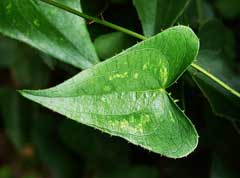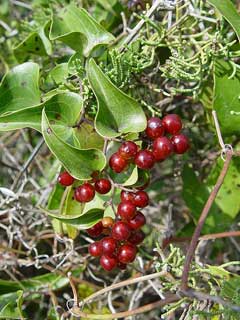 |
|
http://commons.wikimedia.org/wiki/User:Esculapio |
 |
| http://commons.wikimedia.org/wiki/User:Lumbar |
Translate this page:
Summary
Physical Characteristics

 Smilax aspera is an evergreen Climber growing to 3 m (9ft 10in).
Smilax aspera is an evergreen Climber growing to 3 m (9ft 10in).
See above for USDA hardiness. It is hardy to UK zone 9. It is in leaf all year, in flower from August to September. The species is dioecious (individual flowers are either male or female, but only one sex is to be found on any one plant so both male and female plants must be grown if seed is required). . The plant is not self-fertile.
Suitable for: light (sandy), medium (loamy) and heavy (clay) soils. Suitable pH: mildly acid, neutral and basic (mildly alkaline) soils. It can grow in semi-shade (light woodland) or no shade. It prefers moist soil.
UK Hardiness Map
US Hardiness Map
Synonyms
S. mauritanica. S. nigra.
Plant Habitats
Woodland Garden Sunny Edge; Dappled Shade; Hedge;
Edible Uses
Edible Parts: Leaves Root Shoots
Edible Uses: Drink
Young shoots - raw or cooked as a vegetable[89, 100, 148, 183, 272]. They can be cooked and used as an asparagus substitute. The tendrils are also eaten[148]. The plant is an ingredient of soft drinks[7, 14]. (this probably refers to the root)
References More on Edible Uses
Medicinal Uses
Plants For A Future can not take any responsibility for any adverse effects from the use of plants. Always seek advice from a professional before using a plant medicinally.
Alterative Antipsoriatic Demulcent Depurative Diaphoretic Diuretic Parasiticide Stimulant
Tonic
The root is alterative, demulcent, depurative, diaphoretic, diuretic, stimulant and tonic[7, 14]. This is one of the best depurative medicines and is used as a springtime tonic and general body cleanser, usually with woody nightshade (Solanum dulcamara)[7]. The root has all the medicinal virtues of the widely used tropical herb sarsaparilla, though to a lesser degree[7]. It is often used as an adulterant to that plant[7]. The ripe fruits are squeezed and applied to the skin in the treatment of scabies[272].
References More on Medicinal Uses
The Bookshop: Edible Plant Books
Our Latest books on Perennial Plants For Food Forests and Permaculture Gardens in paperback or digital formats.

Edible Tropical Plants
Food Forest Plants for Hotter Conditions: 250+ Plants For Tropical Food Forests & Permaculture Gardens.
More

Edible Temperate Plants
Plants for Your Food Forest: 500 Plants for Temperate Food Forests & Permaculture Gardens.
More

More Books
PFAF have eight books available in paperback and digital formats. Browse the shop for more information.
Shop Now
Other Uses
References More on Other Uses
Cultivation details
Succeeds in most soils in sun or semi-shade[200]. A very ornamental plant[1], it is only hardy in the mildest areas of Britain[11, 166], tolerating temperatures down to about -10°c[184]. The flowers have a heavy sweet perfume[245]. Dioecious. Male and female plants must be grown if seed is required.
References Carbon Farming Information and Carbon Sequestration Information
Temperature Converter
Type a value in the Celsius field to convert the value to Fahrenheit:
Fahrenheit:
The PFAF Bookshop
Plants For A Future have a number of books available in paperback and digital form. Book titles include Edible Plants, Edible Perennials, Edible Trees,Edible Shrubs, Woodland Gardening, and Temperate Food Forest Plants. Our new book is Food Forest Plants For Hotter Conditions (Tropical and Sub-Tropical).
Shop Now
Plant Propagation
Seed - sow March in a warm greenhouse[1]. This note probably refers to the tropical members of the genus, seeds of plants from cooler areas seem to require a period of cold stratification, some species taking 2 or more years to germinate[K]. We sow the seed of temperate species in a cold frame as soon as we receive it, and would sow the seed as soon as it is ripe if we could obtain it then[K]. When the seedlings eventually germinate, prick them out into individual pots when they are large enough to handle and grow them on in the greenhouse for at least their first year, though we normally grow them on in pots for 2 years. Plant them out into their permanent positions in early summer. Division in early spring as new growth begins[238]. Larger divisions can be planted out direct into their permanent positions. We have found it best to pot up the smaller divisions and grow them on in a lightly shaded position in a cold frame, planting them out once they are well established in the summer. Cuttings of half-ripe shoots, July in a frame[238].
Other Names
If available other names are mentioned here
Native Range
TEMPERATE ASIA: Cyprus, Israel, Jordan, Lebanon, Syria, Turkey TROPICAL ASIA: Bhutan, India, Sri Lanka, Nepal EUROPE: Former Yugoslavia, Albania, Greece (incl. Crete), Italy (incl. Sardinia, Sicily), Spain (incl. Baleares), France (incl. Corsica), Portugal AFRICA: Spain (Canarias), Portugal (Madeira Islands), Algeria, Libya, Morocco, Ethiopia, Kenya, Tanzania, Uganda, Democratic Republic of the Congo, Malawi, Zambia
Weed Potential
Right plant wrong place. We are currently updating this section.
Please note that a plant may be invasive in one area but may not in your area so it's worth checking.
Conservation Status
IUCN Red List of Threatened Plants Status :

Growth: S = slow M = medium F = fast. Soil: L = light (sandy) M = medium H = heavy (clay). pH: A = acid N = neutral B = basic (alkaline). Shade: F = full shade S = semi-shade N = no shade. Moisture: D = dry M = Moist We = wet Wa = water.
Now available:
Food Forest Plants for Mediterranean Conditions
350+ Perennial Plants For Mediterranean and Drier Food Forests and Permaculture Gardens.
[Paperback and eBook]
This is the third in Plants For A Future's series of plant guides for food forests tailored to
specific climate zones. Following volumes on temperate and tropical ecosystems, this book focuses
on species suited to Mediterranean conditions—regions with hot, dry summers and cool, wet winters,
often facing the added challenge of climate change.
Read More
Expert comment
Author
L.
Botanical References
11200266
Links / References
For a list of references used on this page please go here
Readers comment
| Add a comment |
|
If you have important information about this plant that may help other users please add a comment or link below. Only comments or links that are felt to be directly relevant to a plant will be included. If you think a comment/link or information contained on this page is inaccurate or misleading we would welcome your feedback at [email protected]. If you have questions about a plant please use the Forum on this website as we do not have the resources to answer questions ourselves.
* Please note: the comments by website users are not necessarily those held by PFAF and may give misleading or inaccurate information.
To leave a comment please Register or login here All comments need to be approved so will not appear immediately.
|
|